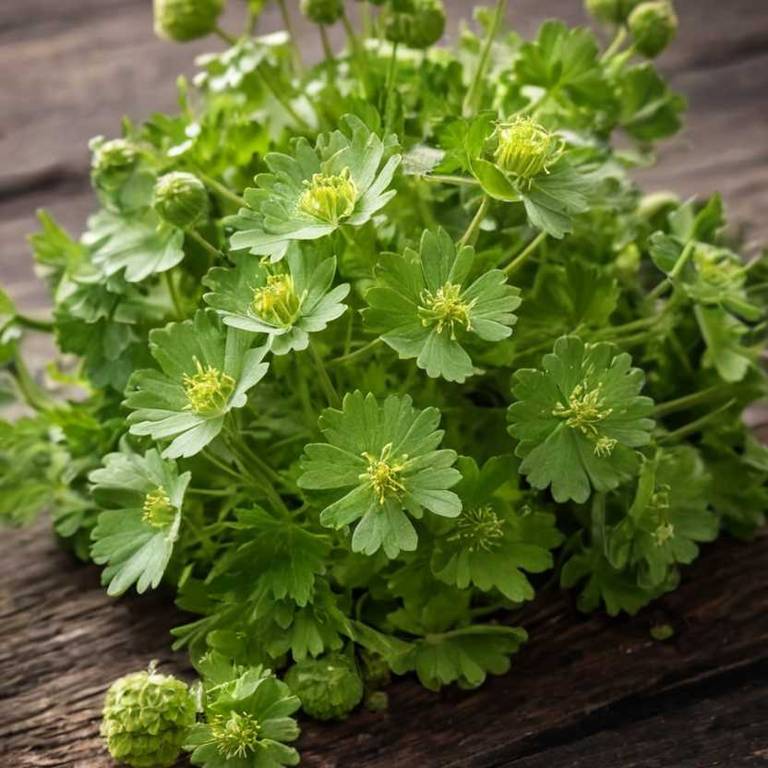By Leen Randell
Updated: Jul 06, 2024
What to know about Alchemilla vulcanica (lady's mantle) before using it medicinally

Alchemilla vulcanica, commonly known as lady's mantle, is a herbaceous plant renowned for its exceptional health-enhancing properties, which have been found to soothe digestive issues and alleviate symptoms of anxiety and stress.
This versatile herb is relatively easy to cultivate, thriving in moist, well-drained soil and partial shade, making it a popular choice for gardeners and herbalists alike. From a botanical standpoint, Alchemilla vulcanica is a member of the rose family (Rosaceae) and is characterized by its distinctive, umbrella-like flowers and heart-shaped leaves.
In traditional medicine, the herb has been referenced as far back as ancient Greece and Rome, where it was used to treat a range of ailments, including fever and menstrual cramps.
This article explains the medicinal, horticultural, botanical, and historical aspects of Alchemilla vulcanica.
What are the medicinal properties of Alchemilla vulcanica?
Alchemilla vulcanica helps with digestive issues, such as bloating, nausea, and diarrhea, due to its anti-inflammatory and carminative properties. It also soothes menstrual cramps and alleviates symptoms of PMS.
The active constituents of Alchemilla vulcanica include flavonoids, phenolic acids, and tannins, which contribute to its medicinal properties. These compounds exhibit anti-inflammatory, antioxidant, and astringent effects.
The leaves and flowers of Alchemilla vulcanica are the most commonly used parts for medicinal purposes. They can be used in infusions, tinctures, or ointments to exploit their therapeutic benefits.
Possible side effects of Alchemilla vulcanica include allergic reactions, such as skin rashes and itching, when used in large quantities or without proper preparation. It can also interact with certain medications, such as blood thinners.
When using Alchemilla vulcanica medicinally, precautions should be taken to avoid excessive dosages, particularly for pregnant or breastfeeding women, and individuals with bleeding disorders, as it can prolong bleeding time.
What are the horticulural aspects of Alchemilla vulcanica?
Alchemilla vulcanica grow in a range of soils but prefer moist, well-drained conditions with partial shade. They thrive in USDA zones 3-9, tolerating temperatures from -40°C to 35°C. Average annual rainfall of 500-700 mm supports their growth.
Planting tips for Alchemilla vulcanica include planting in spring or autumn, about 30-60 cm apart. Dig a hole twice as wide and as deep as the root ball, adding organic matter to improve drainage. Plant at the same depth as before and water regularly during the first growing season.
Harvesting tips for Alchemilla vulcanica involve cutting stems when flowers fade in summer, removing spent flowers to encourage more blooms. Leave some stems intact for seed production. Pinch off seed heads in autumn to maintain plant shape and prevent self-seeding.
Pests and diseases affecting Alchemilla vulcanica include aphids, slugs, and snails, which can be controlled with insecticidal soap or horticultural oil. Fungal diseases like leaf spot and powdery mildew require treatment with fungicides. Regular monitoring and good hygiene practices help prevent infestations.
What are the botanical aspects of Alchemilla vulcanica?
Alchemilla vulcanica is a perennial plant characterized by its rosette of leaves and yellow flowers in a dense panicle. The leaves are typically 2-5 cm long, pinnate with 5-9 leaflets, and have a hairy petiole. Stems are 10-50 cm tall, erect, and slightly hairy.
Alchemilla vulcanica is classified in the family Rosaceae, subfamily Rosoideae, tribe Rosae, and genus Alchemilla. Its species name, vulcanica, refers to its volcanic distribution in the Andes. The plant is also known as lady's mantle due to its leaf shape resembling a mantle.
Variants of Alchemilla vulcanica include A. v. subsp. vulcanica, found in Argentina and Chile, and A. v. subsp. pumila, found in central Argentina. A. v. subsp. vulcanica has larger flowers and more robust stems, while A. v. subsp. pumila has smaller flowers and less robust stems.
Alchemilla vulcanica is native to the Andes mountain range in Argentina, Chile, and Bolivia. It grows in open, dry areas at high altitudes (2,500-3,500 m). The plant is often found on rocky outcrops, ridges, and slopes with well-drained soils.
The life cycle of Alchemilla vulcanica begins with germination of seeds in autumn. The plant grows and develops its rosette of leaves in winter and spring. In summer, it produces yellow flowers in a dense panicle. After flowering, the plant goes dormant in winter, and the cycle repeats itself.
What are the historical aspects of Alchemilla vulcanica?
Alchemilla vulcanica is a perennial herb used historically for medicinal purposes, particularly in treating digestive issues, such as diarrhea, and skin conditions. It was also used as a treatment for fever and rheumatism.
In mythology, Alchemilla vulcanica is associated with the goddess of the hunt, Artemis, who was often depicted wearing a cloak of leaves. The plant's name "vulcanica" refers to its affinity for volcanic regions.
In symbolism, Alchemilla vulcanica represents protection and nurturing qualities, possibly due to its use as a protective covering for delicate flowers. It was also associated with the element of earth and stability.
Alchemilla vulcanica is mentioned in the historical text "De Materia Medica" by Dioscorides, a Greek physician, where it is listed as a treatment for various ailments. The text describes the plant's properties and how it was used.
Roman mosaics and Greek pottery often feature images of Alchemilla vulcanica, indicating its significance in ancient art and culture. Additionally, archaeological finds have revealed ancient plant remains and artifacts related to its use.